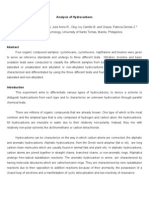0 ratings0% found this document useful (0 votes)
126 viewsAnatomy Prostate
Anatomy Prostate
Uploaded by
navjavThe document describes the anatomy of the urinary bladder, prostate, and male urethra. It details the locations and structures of these organs, including their blood supply and lymphatic drainage. It also outlines the different parts of the male urethra and notable features within the prostate and urethra.
Copyright:
© All Rights Reserved
Available Formats
Download as PDF, TXT or read online from Scribd
Anatomy Prostate
Anatomy Prostate
Uploaded by
navjav0 ratings0% found this document useful (0 votes)
126 views2 pagesThe document describes the anatomy of the urinary bladder, prostate, and male urethra. It details the locations and structures of these organs, including their blood supply and lymphatic drainage. It also outlines the different parts of the male urethra and notable features within the prostate and urethra.
Original Description:
anatomy of the prostate
Copyright
© © All Rights Reserved
Available Formats
PDF, TXT or read online from Scribd
Share this document
Did you find this document useful?
Is this content inappropriate?
The document describes the anatomy of the urinary bladder, prostate, and male urethra. It details the locations and structures of these organs, including their blood supply and lymphatic drainage. It also outlines the different parts of the male urethra and notable features within the prostate and urethra.
Copyright:
© All Rights Reserved
Available Formats
Download as PDF, TXT or read online from Scribd
Download as pdf or txt
0 ratings0% found this document useful (0 votes)
126 views2 pagesAnatomy Prostate
Anatomy Prostate
Uploaded by
navjavThe document describes the anatomy of the urinary bladder, prostate, and male urethra. It details the locations and structures of these organs, including their blood supply and lymphatic drainage. It also outlines the different parts of the male urethra and notable features within the prostate and urethra.
Copyright:
© All Rights Reserved
Available Formats
Download as PDF, TXT or read online from Scribd
Download as pdf or txt
You are on page 1of 2
RENAL AND UROLOGY
Anatomy of the urinary
bladder, prostate and male
urethra
Posterosuperior aspect of the male internal
urogenital organs
Urachus
Harold Ellis
Deferent
duct
This contribution should be read with Role of the bladder in
storage and micturition, page 93, and Urinary incontinence in
adults, page 101.
Ureter
Urinary bladder (Figure 1)
The empty bladder is extraperitoneal and roughly pyramidal.
Superiorly it is covered by the pelvic peritoneum, with coils of
small intestine and the sigmoid loop lying against it. In the female,
the anteverted body of the uterus lies against its posterosuperior
aspect.
Anteriorly, the bladder lies behind the pubis, with its apex
attached by a fibrous strand, the median umbilical ligament, to
the umbilicus. This represents the remains of the fetal urachus.
Posteriorly in the male, the base of the bladder relates to the
rectum, the vasa deferentia and the seminal vesicles; in the female,
to the vagina and the supravaginal cervix. It receives the ureters at
its upper lateral angles. Laterally, the inferolateral surfaces relate
to the levator ani and obturator internus muscles on each side.
The bladder neck fuses with the male prostate; in the female
it rests directly on the pelvic fascia.
As the bladder distends, in retention of urine it becomes spherical and projects into the lower abdomen, stripping the peritoneum
upwards from the anterior abdominal wall. This allows safe extraperitoneal puncture of the distended bladder to be performed.
In the infant, because the pelvis is comparatively small, the
bladder neck is level with the upper part of the symphysis and the
bladder itself, although still extraperitoneal, is in contact with the
anterior abdominal wall.
The interior of the bladder is readily visualized through the
cystoscope (Figure 2). The ureteric orifices are seen as a slit on
either side. Between them, a raised fold of mucosa, the interureteric ridge, is constantly visible, produced by an underlying bar
of muscle. Between the ureteric orifices and the urethral orifice is
the smooth triangular area of the trigone.
The involuntary muscle of the bladder wall is formed by a
criss-cross of fibres. When these undergo hypertrophy as a result
of chronic urethral obstruction, they produce the characteristic
trabeculated appearance at cystoscopy.
Seminal
vesicle
Prostate
Membranous part of urethra
Anterior aspect of the interior of the urinary bladder
Probe in
right ureter
Interureteric
crest
Orifice of
left ureter
Trigone
Uvula
Internal
urethral
orifice
Harold Ellis is Emeritus Professor of Surgery, University of London
(Charing Cross and Westminster Medical School), London, UK. He is
Clinical Anatomist in the Division of Anatomy at Kings College, London,
at the Guys Campus, London, UK.
SURGERY 23:3
97
2005 The Medicine Publishing Company Ltd
RENAL AND UROLOGY
Blood supply is from the superior and inferior vesical branches
of the internal iliac artery. The vesical veins form a plexus which
drains into the internal iliac vein.
Lymphatics drain along the vesical blood vessels to the iliac
and then the para-aortic nodes.
The whole length of the lumen of the male urethra
exposed by an incision extending into it from its
dorsal aspect
Bladder
Prostate
Prostate
Urethral crest
Colliculus seminalis
The prostate gland is a pyramidal fibromuscular and glandular
organ, the size and shape of a chestnut, that surrounds the commencement of the urethra.
Above, it continues with the neck of the bladder, the urethra
entering near its anterior border. Below, the apex of the gland rests
on the sphincter urethrae, which lies within the deep perineal
pouch.
Behind lies the rectum, separated by the loose fascia of Denonvilliers, while in front lies the pubic symphysis separated from it
by extraperitoneal fat in the retropubic space (cave of Retzius).
Close against the prostate in this space lies the prostatic plexus
of veins. Near its apex, a condensation of connective tissue, the
puboprostatic ligament, passes forward to the pubis.
Laterally lies the levator ani. On either side the ejaculatory
duct, formed by fusion of the vas and the seminal vesicle, enters
the upper posterior part of the prostate to open into the urethra
at the colliculus seminalis (see below), thus dividing off a median
prostatic lobe between them.
The arterial supply of the gland is from the inferior vesical
artery, a branch entering the prostate on each side at its lateral
extremity.
The prostatic plexus of veins receives the dorsal vein of the
penis and drains into the internal iliac vein on each side. Some of
the venous drainage connects with valveless vertebral veins (the
valveless vertebral veins of Bateson), which explains the spread
of prostatic cancer to the pelvis and vertebrae.
Prostatic part of urethra
Membranous part
of urethra
Bulb
Crus
Corpus cavernosum
penis
Corpus spongiosum
penis
Spongy part of urethra
Small lacuna
Large lacuna in
navicular fossa
External urethral orifice
Male urethra (Figure 3)
Openings of prostatic utricle and ejaculatory ducts on the
colliculus seminalis.
The male urethra is 1820 cm in length and is divided into the
prostatic, membranous and spongy parts.
The prostatic urethra
The prostatic urethra is 34 cm in length and traverses the prostate. Its posterior wall bears a longitudinal elevation along its
length termed the urethral crest. On each side of this is the shallow groove of the prostatic sinus, into which the 1520 prostatic
ducts empty the secretion of the gland. At about the middle of the
crest is a prominence, the colliculus seminalis (or verumontanum)
into which opens the prostatic utricle, or utriculus masculinus, a
blind tract about 5 mm in length. This is believed to be the male
remnant of the paramesonephric duct, which develops into the
female genital tract. On either side of the utricle open the ejaculatory ducts.
The spongy urethra
The spongy urethra is 15 cm in length and traverses the corpus
spongiosum of the penis. First, it passes upwards and forwards to
lie below the pubic symphysis (the bulb of the urethra); then, in
the flaccid state, it bends downwards and forwards. The external
orifice, a vertical slit, is the narrowest part of the urethra. Immediately within the meatus, the urethra dilates into a terminal fossa,
the roof of which bears a mucosal fold, the lacuna magna, which
may catch the tip of a catheter.
The membranous urethra
The membranous urethra is 2 cm in length, the shortest, least
dilatable and, apart from the external orifice, the narrowest part
of the urethra. It traverses the external urethral sphincter within
the deep perineal pouch.
SURGERY 23:3
98
2005 The Medicine Publishing Company Ltd
You might also like
- Assessment - TeacherDocument165 pagesAssessment - Teacherlesterbekker1981No ratings yet
- Lymphatic Drainage of The Head and Neck - AatifDocument6 pagesLymphatic Drainage of The Head and Neck - AatifAatif AnsariNo ratings yet
- 8.11.08 Davis-Hovda. TB PleurisyDocument13 pages8.11.08 Davis-Hovda. TB Pleurisyawaniedream8391No ratings yet
- The Circulatory System BookletDocument30 pagesThe Circulatory System BookletTroy CampbellNo ratings yet
- Science Form 1 - Chapter 1.1 by KelvinDocument33 pagesScience Form 1 - Chapter 1.1 by KelvinKelvin100% (2)
- Anatomy of Urinary BladderDocument5 pagesAnatomy of Urinary BladderyolandadwiooNo ratings yet
- Anatomy ProstateDocument2 pagesAnatomy ProstateCarl Julienne MasangcayNo ratings yet
- Scrotum & Testis: Dr. Suresh Managutti, Assistant Professor Department of Anatomy SDM College of Physiotherapy, DharwadDocument40 pagesScrotum & Testis: Dr. Suresh Managutti, Assistant Professor Department of Anatomy SDM College of Physiotherapy, DharwadsureshmanguttiNo ratings yet
- Physiology of Skeletal Muscle by Dr. RoomiDocument33 pagesPhysiology of Skeletal Muscle by Dr. RoomiMudassar RoomiNo ratings yet
- Amputation Lower ExtremityDocument5 pagesAmputation Lower ExtremityJulia SalvioNo ratings yet
- The Transplantation of Human Organs Act, 1994: DR Amit Gupta Associate Professor Dept of SurgeryDocument63 pagesThe Transplantation of Human Organs Act, 1994: DR Amit Gupta Associate Professor Dept of SurgeryDr Suhas BavikarNo ratings yet
- DissertationDocument7 pagesDissertationChandra SekharNo ratings yet
- Circumcision Using The Mogen ClampDocument4 pagesCircumcision Using The Mogen ClampJorge AndrésNo ratings yet
- Anatomy of The Kidney & Ureter - NewDocument42 pagesAnatomy of The Kidney & Ureter - NewHaider Nadhem AL-rubai0% (1)
- Introduction To The Topographical Anatomy and Operative SurgeryDocument43 pagesIntroduction To The Topographical Anatomy and Operative SurgeryKavan Vyas100% (1)
- Treatment and Rehabilitation of FracturesDocument30 pagesTreatment and Rehabilitation of FracturesJulia SalvioNo ratings yet
- Introduction To UrologyDocument48 pagesIntroduction To UrologyvaiyenNo ratings yet
- Scrotum Anatomy and Scanning TechniqueDocument7 pagesScrotum Anatomy and Scanning TechniqueAnonymous wyF4yQZwZNo ratings yet
- Histology Practical Manual Part 1 2021Document124 pagesHistology Practical Manual Part 1 2021khushikumari1407100% (1)
- Posterior Abdominal WallDocument59 pagesPosterior Abdominal WallAmeen ShaikNo ratings yet
- Urologic Emergencies: Hakan Koyuncu MD Associate Professor Yeditepe University Medical Faculty Department of UrologyDocument62 pagesUrologic Emergencies: Hakan Koyuncu MD Associate Professor Yeditepe University Medical Faculty Department of UrologycoassrunNo ratings yet
- Physiology of ANS Lecture 1 by Dr. Mudassar Ali RoomiDocument19 pagesPhysiology of ANS Lecture 1 by Dr. Mudassar Ali RoomiMudassar RoomiNo ratings yet
- Chapter 20 - Embryology of The Genitourinary Tract - Campbell - Walsh-Wein UROLOGY 12thDocument40 pagesChapter 20 - Embryology of The Genitourinary Tract - Campbell - Walsh-Wein UROLOGY 12thkrisnaNo ratings yet
- Gynaecomastia FinalizedDocument18 pagesGynaecomastia FinalizedAdamNo ratings yet
- Utility of Murphy's Repertory in Management of Cases of HaemorrhoidsDocument4 pagesUtility of Murphy's Repertory in Management of Cases of HaemorrhoidsEditor IJTSRDNo ratings yet
- Management of Foreskin ConditionsDocument26 pagesManagement of Foreskin ConditionsSarif CassanovaNo ratings yet
- 4.bones of Upper LimbDocument32 pages4.bones of Upper Limbrahul maurya0% (1)
- Micturition 2022Document20 pagesMicturition 2022Mohammad zreadNo ratings yet
- Regulation of Cardiac Output and Venous Return by Dr. RoomiDocument44 pagesRegulation of Cardiac Output and Venous Return by Dr. RoomiMudassar RoomiNo ratings yet
- Surgical Female Urogenital Anatomy - UpToDateDocument57 pagesSurgical Female Urogenital Anatomy - UpToDateErick100% (1)
- Development of Male Reproductive SystemDocument21 pagesDevelopment of Male Reproductive SystemOgunsusi DamilolaNo ratings yet
- Coronary Artery Bypass GraftDocument30 pagesCoronary Artery Bypass GraftKatrina Mae RamirezNo ratings yet
- The Neck / Firas Al-Hameed by Rusul AnwarDocument7 pagesThe Neck / Firas Al-Hameed by Rusul Anwarزين العابدين محمد عويشNo ratings yet
- Scapular RegionDocument21 pagesScapular RegionNick KlyshkoNo ratings yet
- BPH and CA ProstateDocument75 pagesBPH and CA ProstatelohithNo ratings yet
- Chapter 6 Genital SystemDocument32 pagesChapter 6 Genital Systemapi-19916399No ratings yet
- Anatomy of The Male Reproductive SystemDocument10 pagesAnatomy of The Male Reproductive SystemSerious LeoNo ratings yet
- Dr. Niranjan Murthy H L: Asst. Prof., Dept. of Physiology Sree Siddhartha Medical College & Hospital, TumkurDocument29 pagesDr. Niranjan Murthy H L: Asst. Prof., Dept. of Physiology Sree Siddhartha Medical College & Hospital, Tumkurnirilib100% (6)
- Examination of Chronic AbdomenDocument43 pagesExamination of Chronic AbdomendrrajeshpsmsNo ratings yet
- Head and Neck AnatomyDocument131 pagesHead and Neck AnatomyKatrine Danielle GuardiansNo ratings yet
- Aorta AnatomyDocument41 pagesAorta AnatomySingey LhendupNo ratings yet
- Pelvis and Perineum Clinical CorrelationDocument4 pagesPelvis and Perineum Clinical CorrelationKeesha Mariel Alimon100% (1)
- Urogenital TumorDocument71 pagesUrogenital TumorJanet UngNo ratings yet
- Anatomy of PeritoneumDocument61 pagesAnatomy of PeritoneumFirdaus SeptiawanNo ratings yet
- Malereproductive (Author T.globa)Document40 pagesMalereproductive (Author T.globa)Cristina caimac100% (1)
- 2ND MBBS Anatomy Viva QuesstionsDocument9 pages2ND MBBS Anatomy Viva QuesstionsUzochukwu UmesiamaNo ratings yet
- Physiology of Excitation and Conduction System of Heart by Dr. Mudassar Ali RoomiDocument17 pagesPhysiology of Excitation and Conduction System of Heart by Dr. Mudassar Ali RoomiMudassar Roomi100% (2)
- Introduction To Histology and Epithelium TissueDocument48 pagesIntroduction To Histology and Epithelium TissuejabirNo ratings yet
- DuodenumDocument47 pagesDuodenumAarish KanwatNo ratings yet
- Med&upd&vol 31&2021Document1,525 pagesMed&upd&vol 31&2021Rajesh KumarNo ratings yet
- Femoral TriangleDocument41 pagesFemoral Triangleravindra sharmaNo ratings yet
- Congenital Deformities: Gay G. Crisostomo-San Antonio, PTRP, MDDocument46 pagesCongenital Deformities: Gay G. Crisostomo-San Antonio, PTRP, MDJulia SalvioNo ratings yet
- SpleenDocument44 pagesSpleenHarnarayan Jeev Singh BajajNo ratings yet
- Large Blood Vessels of The GutDocument61 pagesLarge Blood Vessels of The GutpoojaNo ratings yet
- History of MedicineDocument18 pagesHistory of MedicineAna Francisca Feliz MatosNo ratings yet
- 20th & 21st Century Medicine NewDocument22 pages20th & 21st Century Medicine NewJulian GordonNo ratings yet
- SleDocument66 pagesSlebhushan vichare100% (1)
- Abdominal OrgansDocument28 pagesAbdominal OrgansRS BuenavistaNo ratings yet
- Ethics in MedicineDocument24 pagesEthics in Medicinekavi priyaNo ratings yet
- The Male Reproductive SystemDocument14 pagesThe Male Reproductive SystemmarkkkkkkkheeessNo ratings yet
- Mediastinum and Its ContentsDocument11 pagesMediastinum and Its ContentsPap YeeNo ratings yet
- Thorax 1Document109 pagesThorax 1Insyirah JohariNo ratings yet
- Dichotomous KeysDocument8 pagesDichotomous KeysTal4shinNo ratings yet
- P.E 101 Mod. 1 First Sem PDFDocument14 pagesP.E 101 Mod. 1 First Sem PDFabcdNo ratings yet
- GS - EnvironmentDocument51 pagesGS - EnvironmentAnjaiah PotharajulaNo ratings yet
- Histological Typing of Kidney TumoursDocument72 pagesHistological Typing of Kidney TumoursrmysdsNo ratings yet
- Biochemistry 4.3 Electrolytes in GIT - MendozaDocument4 pagesBiochemistry 4.3 Electrolytes in GIT - Mendozalovelots1234No ratings yet
- Bio G9 T3 P1Document16 pagesBio G9 T3 P1Leena BhaiNo ratings yet
- LARGE ANIMAL - Georgina Child - Large Animal Neurological Exam PDFDocument8 pagesLARGE ANIMAL - Georgina Child - Large Animal Neurological Exam PDFYaserAbbasiNo ratings yet
- Literature Review Presentation For ProjectsDocument7 pagesLiterature Review Presentation For Projectsomer faruk yıldıranNo ratings yet
- Anatomy and Histology of SkinDocument10 pagesAnatomy and Histology of SkinFlorence LauNo ratings yet
- UGEB2363-1718-week 5 To 6Document70 pagesUGEB2363-1718-week 5 To 6Gladys Gladys MakNo ratings yet
- Reiki Is A Great Tool For Stress Reduction and Relaxation (!)Document16 pagesReiki Is A Great Tool For Stress Reduction and Relaxation (!)vaniaNo ratings yet
- Rosemary Monograph - HerbRallyDocument5 pagesRosemary Monograph - HerbRallykatNo ratings yet
- Biomolecules and Chemical Reaction LPDocument23 pagesBiomolecules and Chemical Reaction LPMark TomoNo ratings yet
- Anatomy and Physiology The HeartDocument21 pagesAnatomy and Physiology The HeartUfuq Azmi BasyarNo ratings yet
- Formal Report 1Document6 pagesFormal Report 1Patricia Denise OrquiaNo ratings yet
- Waste Water Treatment Enzymes Organic Envirozyme PRDocument5 pagesWaste Water Treatment Enzymes Organic Envirozyme PRManish SinghalNo ratings yet
- Mini Protean TGX Precast GelsDocument6 pagesMini Protean TGX Precast GelsKai PacNo ratings yet
- LSM1102 - Practical Session 8 Population GeneticsDocument18 pagesLSM1102 - Practical Session 8 Population Geneticsgivena2ndchance100% (1)
- The Fossil Record: Getting StartedDocument8 pagesThe Fossil Record: Getting StartednidhiNo ratings yet
- Review of LaboratoryDocument48 pagesReview of LaboratoryIkhar RidhoNo ratings yet
- Biology - Scheme - Form - 2 - (1) Schemes 2021Document12 pagesBiology - Scheme - Form - 2 - (1) Schemes 2021Changamkia WorksNo ratings yet
- Dafpus LapresDocument3 pagesDafpus LapresTyasNo ratings yet
- Weeds of Rice in Asia PDFDocument120 pagesWeeds of Rice in Asia PDFjuliNo ratings yet
- My Eassy DibetesDocument5 pagesMy Eassy DibetesSunil BhattNo ratings yet
- Clara LimDocument5 pagesClara LimAna LynNo ratings yet
- PPT MA - RevisiDocument76 pagesPPT MA - RevisiullifannuriNo ratings yet
- 2011.XN - Clinical Reference Range EngDocument3 pages2011.XN - Clinical Reference Range EngWangKevinNo ratings yet

























































































